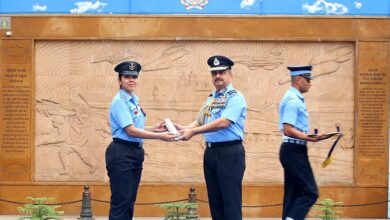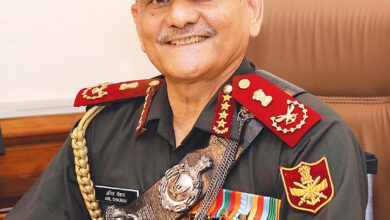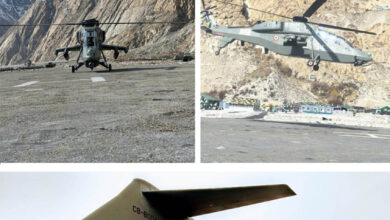No Survivors in IAF An-32 Aircraft Crash in Arunachal

New Delhi. All the 13 crew and personnel on board the ill-fated An-32 transport aircraft of the Indian Air Force (IAF) that crashed in north-eastern India on June 3 had perished.
IAF announced this with regret, just as a team of 15 professional mountaineers, including two Everesteers, reached the crash site and recovered the aircraft’s Cockpit Voice Recorder and Flight Data Recorder, or the Black Box, on June 14. They were air-dropped near the location by IAF’s Mi-17 helicopters.
Rescue teams had reached the crash site, with massive effort, and had secured the bodies of crash victims in body bags. But because of the bad weather, even this rescue attempt was facing limitations. The bodies would be recovered as and when the weather improves, and then possibly winched up to helicopters.
IAF officers and personnel are on a 24 x 7 standby waiting for some window in weather to be able to operate.
The district administration, coordinated by Deputy Commissioner Rajeev Takuk, was giving a tremendous helping hand to IAF by mobilizing local resources. They found all the bodies in the aircraft, which had apparently hit a mountain side at 12,000 feet. The weather was possibly blinding then, and although an inquiry is yet to take place, it is possible that the pilots had tried to fly over the mountain but there wasn’t much distance available for a hump over the hidden cliffs.
For the inquiry to take place, somebody would have to go down to the crash site, and only then it would be possible to draw firm conclusions. The weather continues to be bad enough for that also. An investigation into the likely cause of crash is mandatory by a procedural Court of Inquiry.
IAF has released the list of victims, after first informing the families and next of kin of these martyrs.
The Air Warriors lost in the mishap are:
- Wg Cdr GM Charles
- Sq Ldr H Vinod
- Flt Lt R Thapa
- Flt Lt R Tanwar
- Flt Lt S Mohanty
- Flt Lt MK Garg
- Warrant Officer KK Mishra
- Sergeant Anoop Kumar S
- Corporal Sharin NK
- Leading Aircraftsman SK Singh
- Leading Aircraftman Pankaj
- NCE Putali, and
- NCE Rajesh Kumar
Indian Air Force (IAF) had deployed satellites and high powered sensor assets to locate the wreckage of the missing An-32, but finally it was a Mi-17 which made the visual confirmation on June 11, eight days after the aircraft was lost while on a routine flight from Jorhat in Assam to Mechuka in Arunachal Pradesh.
IAF issued a press statement shortly after the Mi-17, part of the massive Search and Rescue effort, spotted the wreckage in the tough, mountainous terrain at a height of about 12,000 feet. Notably, there are blinding and unpredictable clouds, occasionally cumulonimbus, and from indications it appears that the aircraft crashed into a mountain. There are very dense forests.

A picture of the area from GoogleEarth indicates that it would have been very difficult for the search parties to have reached there. IAF mobilised immediate help from locals and the civil authorities for the rescue of possible survivors.
IAF routinely flies daily sorties over these mountains to keep up the supply lines, and the Indian Army of course has been there to help and is coordinating with the search efforts. IAF in fact sustains the lifeline for the troops in that region.
In the recent past IAF has been able to considerably improve the long-existing half a dozen Advanced Landing Grounds (ALGs) in the area, under its Modernisation of Airfield Infrastructure (MAFI) programme which commenced in 2008, These World War II era ALGs were established in deep valleys wherever some flat land could be found to create small airstrips – one of them being Machuka where the aircraft was headed.

According to the IAF statement, the wreckage of An-32 was “spotted June 11th 16 Km North of Lipo, North East of Tato at an approximate elevation of 12000 ft by an IAF Mi-17 Helicopter undertaking search in the expanded search zone.” It appears that if the aircraft had not crashed, it would have reached its destination in about 10-15 minutes.
The ill-fated An-32 had gone missing on June 3rd, while on a routine flight after getting airborne from Air Force Station, Jorhat in Assam.
It may be recalled that in 2009, in a similar mishap, an An-32 which had taken off from Mechuka for Jorhat, had also crashed with a similar number of crew and passengers, 13. A rather strange coincidence.
IAF had acquired more than 100 An-32s from the Soviet Union at Friendship prices, and the aircraft have been the backbone of IAF’s transport fleet ever since. They were in fact configured to IAF specifications. But after the split of the Soviet Union, their upgrade is being done in cooperation with Ukraine, where they were manufactured.
But Russia, the emergent power out of the Soviet Union, annexed Ukraine’s Kiev province where the An-32’s factory is located. There is a resulting disruption in the supply of spare parts, and India is trying to way out for some time.
Only about half of IAF’s fleet of 103 An-32s has been upgraded so far, and this particular aircraft had only been “partially upgraded.”





